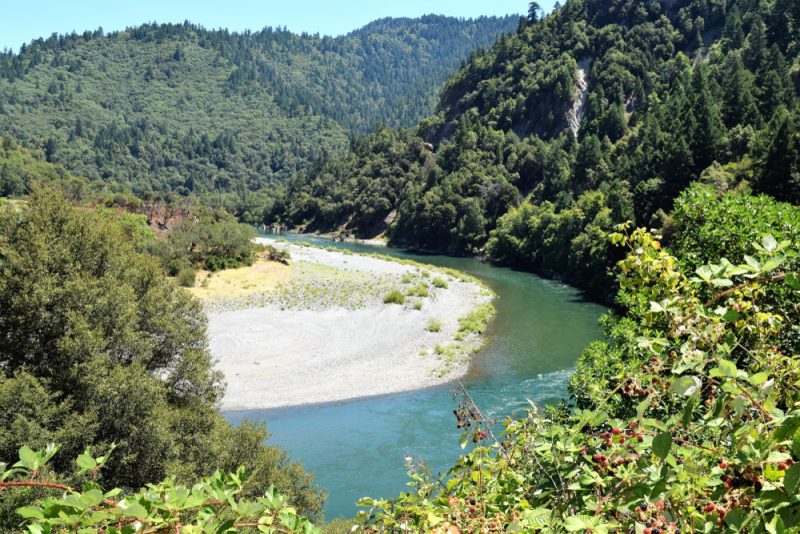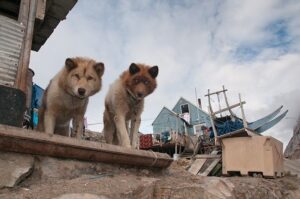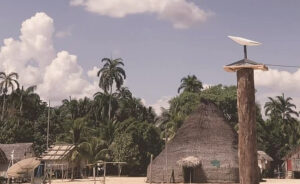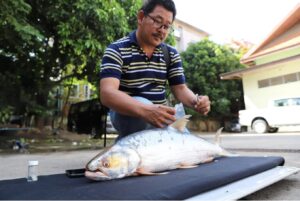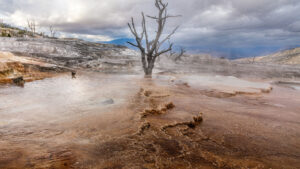In 2024, the U.S. government will remove four hydroelectric dams on the Klamath River. The 414km river runs from Oregon to California, and it used to be one of the highest salmon-producing rivers in the region. Once the removal is complete the river will flow freely for the first time in 100 years. Indigenous communities and environmental activists have been calling for their demolition for decades.
The dams were built between 1911 and 1962 and completely changed the river. It became a trickle, with water that was not fast flowing enough to wash out harmful algae and organisms that cause diseases in the salmon population. Over time the rich salmon stocks died out.

A map showing the Klamath River and its numerous dams. Image: USGS
A decades-long campaign
Indigenous tribes that live in the river basin have been fighting against the dams since their construction. The river is central to their culture and traditions and its salmon populations were a major food source for their communities. Renewed efforts to oppose the dams and call for their destruction came in 2002 when the Chinook salmon populations disappeared completely.
A combination of low water levels and warm temperatures brought the salmon migration to a grinding halt. The slower, shallower water meant parasites that thrive in warmer water were not flushed out of the river. The parasites ravaged the population.
With growing pressure from campaigners, PacifiCorp decided against relicensing the dams in 2022. Maintaining the dams would have required extensive work, all four needed significant repairs. Furthermore, the dams produce limited power in comparison to the needs of nearby populations, making them practically redundant in 2024.
Seven million cubic yards of sediment
The project will be the largest-ever ever dam removal project in America. Copco 2, the smallest of the four dams, was the first to be removed. It came down in the autumn of 2023. This month the water behind the remaining three dams, Iron Gate, Copco 1, and JC Boyle, has been released. The river is flowing freely for the first time in 100 years.
Water gushed out of reservoirs at a pace of 2,000 cubic feet per second and carried with it 7 million cubic yards of sediment.
“This accumulation of sediment from the past 100 years is not natural, so the idea is to move as much of it out during the first push [as possible]. This is the time of year when the river sees the least biological activity. We don’t have to worry about fish runs moving up the river,” Mark Bransom, CEO of the Klamath River Renewal Corp, told the San Francisco Chronicle.

The Iron Gate Dam, California. Photo: Shutterstock
Will the salmon return?
It will take a year for demolition crews to deconstruct the huge structures. Local indigenous tribes and environmentalists are hoping that this will restore the river to its natural state and that the salmon populations will return.
“We’re now pulling the plug and throwing it away. Not to get too mushy about it but being able to look at the river flow for the first time in more than 100 years, it’s incredibly important to us. It’s what we’ve been fighting for, to see the river for itself,” Frankie Myers, vice chair of the Yurok Tribe, told the San Francisco Chronicle.
The removal of the dams is just the start of a years-long restoration project. The next step will be revegetating the huge areas of land that were previously reservoirs. The restoration team has 250,000 trees and shrubs, plus 17 billion seeds to plant. One of the biggest challenges will be getting the new plants into the ground before non-native weeds and plants take hold.
For weeks plant crews have been clearing invasive plants to try and restore the river and surrounding area to its former glory.
“The river needs rehabilitation. It needs restoration. When you think about how long these dams have been in place, they’ve been doing a lot of environmental damage for some time, and it’s going to take time to repair that,” Myers said.
